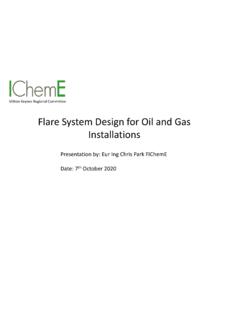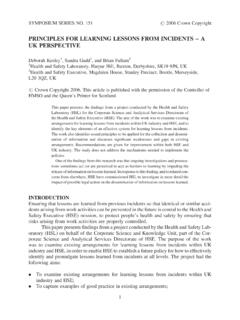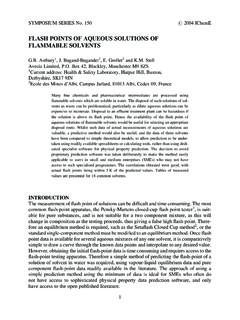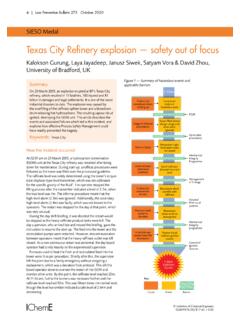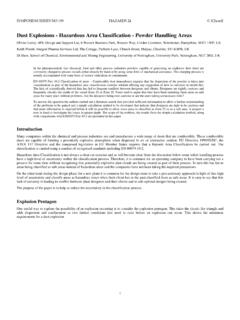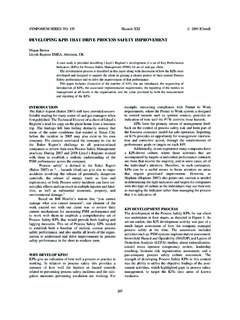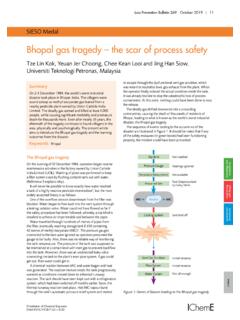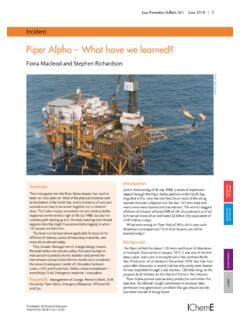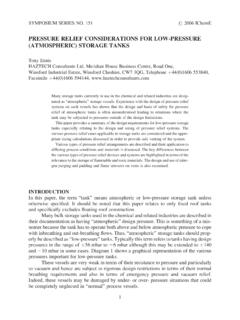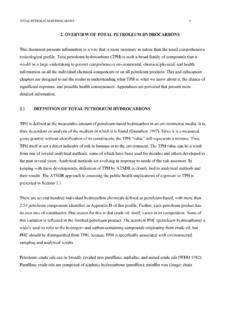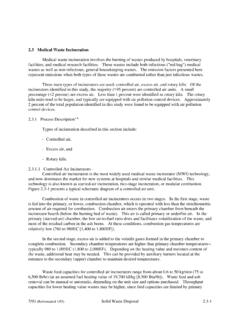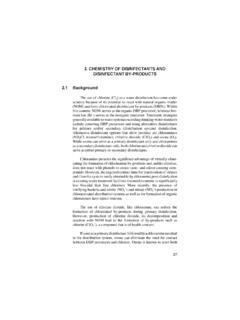Transcription of Flammability and explosibility of ammonia
1 I. CHEM. E. SYMPOSIUM SERIES No. 49 Flammability AND explosibility OF ammonia , Research Dept. ICI Organics Division, Blackley, Manchester The Flammability limits of oxygen/nitrogen/ ammonia mixtures have been determined at ambient temperature, 300o C and 400o C. The explosibility characteristics of ammonia /air mixtures have also been measured. Investigation of the Flammability characteristics of ammonia /water vapour/ air mixtures has shown that no aqueous solution of ammonia gives rise to flammable vapours when its temperature exceeds 49o C. It was also shown that solutions containing less than 5 mol. % ammonia in water do not produce flammable vapours at any temperatures. INTRODUCTION It is well known that vapours of hydrocarbons, hydroxylic compounds and even some chlorinated solvents can form flammable mixtures when mixed with air.
2 The combustible nature of ammonia is much less well known, however, though explosions have occurred both with anhydrous ammonia /air mixtures and with the vapours from aqueous solutions of ammonia mixed with air. Since ammonia is widely used in the gaseous form and also as an aqueous solution for the amination of organic compounds, reliable data is required on the Flammability of both the anhydrous and aqueous material. Some literature data exists on both systems. Coward and Jones (l) have reviewed the literature on the Flammability of ammonia . White (2), Burgoyne and Neal (3), Frank and Doering (4) and Berl and Bausch (5) all obtained experimental data on the Flammability of anhydrous ammonia /air mixtures under atmospheric and elevated pressures. There is inadequate information, however, on ammonia with oxygen deficient atmospheres and on Flammability limits at high temperatures.
3 Even less literature data exist on the Flammability of aqueous ammonia . Some German workers (6) carried out a limited amount of experimental work on this topic, but did not show how their results could be applied to practical situations. The most comprehensive work on the Flammability of both anhydrous and aqueous ammonia was carried out by DeCoursey et al (7). These workers carried out a more systematic examination of the Flammability of ammonia . They did not, however, obtain any data at high temperatures or for oxygen deficient atmospheres. They also used a flat flame burner technique for their work rather than the more conventional open ended ignition tube. The experimental work reported in the present paper was, therefore, carried out to provide more comprehensive data on the Flammability of aqueous solutions of ammonia .
4 Further information on the combustion properties of anhydrous ammonia at high temperatures and with oxygen deficient atmosphereswas also obtained. A limited amount of work was also carried out on the ignition energy and explosibility of ammonia /air mixtures. PART I:- Flammability AND explosibility OF ANHYDROUS ammonia 1. EXPERIMENTAL The apparatus used for the Flammability measurements is shown in Fig (1). This is essentially a 50 mms. internal diameter pyrex glass tube connected in series with a glass solenoid operated circulating pump and a glass sampling vessel. For measurements at ambient temperatures the system was evacuated to a pressure of less than 29 I. SYMPOSIUM SERIES No. 49 2 torr. and ammonia admitted to the required pressure. The solenoid pump was started and the desired premixed supporting atmosphere of oxygen and nitrogen let in until atmospheric pressure was reached.
5 After 20 minutes circulation the pump was switched off and the sampling vessel removed for analysis. The ground glass plate at the base of the tube was removed and a Joule inductance spark passed between the electrodes. The mixture under test was considered to be flammable if a flame travelled away from the electrodes for the full length of the tube. A similar procedure was adopted for measurements at elevated temperatures except that the ammonia / oxygen/nitrogen mixtures were prepared in a heated 6 litre stainless steel bomb at above atmospheric pressure. The heated mixture was then analysed and admitted to the evacuated ignition tube. The ignition tube was surrounded by an electrically wound jacket and any passage of flame along the tube on sparking as observed through slits in the jacket. A few experiments were carried out on the explosibility of ammonia mixtures.
6 In this work the desired mixtures were prepared in the 6 litre bomb, ignited by a hot resistance wire at the centre of the bomb and the maximum explosion pressure and rates of pressure rise measured by a capacitance transducer sited in the vessel wall. Check experiments were carried out in both the stainless steel bomb and the 50 mm. diameter glass tube to see if ammonia was lost by oxidation before the mixture could be ignited. In both cases a maximum of 4% of the ammonia was lost at the highest temperature used (400o C) and the longest residence time in the apparatus. 2. RESULTS Flammability Limit Measurements Flammability limit measurements were carried out at three temperatures - ambient, 500 C and 400 C with supporting atmospheres containing from 21% oxygen (air) down to oxygen. All these experiments were carried out under atmospheric pressure.
7 The results of this work are shown in Fig. (2), where vol. % ammonia in the mixture is plotted against vol. % oxygen in the supporting atmosphere. The data in Fig. (2) show that ammonia behaves in a similar manner to hydrocarbon vapours and the Flammability limits widen as temperature increases. Thus the limits for ammonia in air increase from ammonia in the mixture at ambient temperatures to at 300o C and at 400oC. Compilations of data such as Coward and Jones (1) and Zabetakis (8) give lower limits for ammonia and air at ambient temperatures between and 17-1 vol % and upper limits between and vol %. None of these measurements were carried out with an open ended tube ( at constant pressure), which is the preferred method. The influence of temperature on the Flammability limit has been measured by White (2) and more recently by Rolingson (9).
8 Their results show the same increase in the flammable range with temperature increase as found in the present work. All these higher temperature Flammability limit data are plotted in Fig. (3) together with the more recent literature data of De Coursey et al (7) obtained at ambient temperature using a flat flame burner technique. The value of the lower Flammability limit at ambient temperature found in the present work agrees well with the flat flame burner determinations (7) and with other literature data. Agreement is not as good for the upper limit. This limit is always practically more difficult to measure than the lower limit and both limits are influenced to some extent by the strength of the ignition source. In the experience of the authors powerful ignition sources gun cotton tend to give an unrealistic widening of the limits, particularly if they are measured in a closed vessel.
9 One further parameter shown in Fig.(2) is of importance for application to chemical plant design. This is the minimum oxygen concentration in the supporting atmosphere, below which no ammonia containing mixture will burn. Examination of Fig. (2) shows that this decreases from 17 vol. % oxygen at ambient temperature to at 300o C and at 400o C. These minimum oxygen concentrations are plotted against temperature in Fig. (4) together with similar data obtained under elevated pressure by Buckley and Husa (10). As can be seen all the data lie on a good straight line enabling extrapolation to temperatures of 500-600 C (where experimental work is difficult to be carried out with reasonable accuracy). explosibility Measurements The measurements of the explosibility of ammonia were carried out in a 6 litre stainless steel bomb with ammonia containing mixtures initially under atmospheric pressure.
10 Explosion pressures were measured at the three temperatures - ambient, 300 C and 4 OOoC used in the Flammability limit work, but the only supporting atmosphere investigated was air. 30 The results showed the same characteristics as measurements made with hydrocarbon/air mixtures. Both the maximum explosion pressure and rates of pressure rise gave a maximum value for an ammonia /air mixture with a composition close to the stoichiometric. Tabie (1) shows the maximum values of these 3 parameters together with the maximum explosion pressure and rates of pressure rise for the most explosive mixture of a typical hydrocarbon (pentane) in the same 6 litre bomb. TABLE (1):- explosibility of ammonia (most explosive ammonia /air mixture) m Max. Explosion Temperature (oc) Press (bars) Ambient 300 400 mol % Pentane in air Ambient Av.

